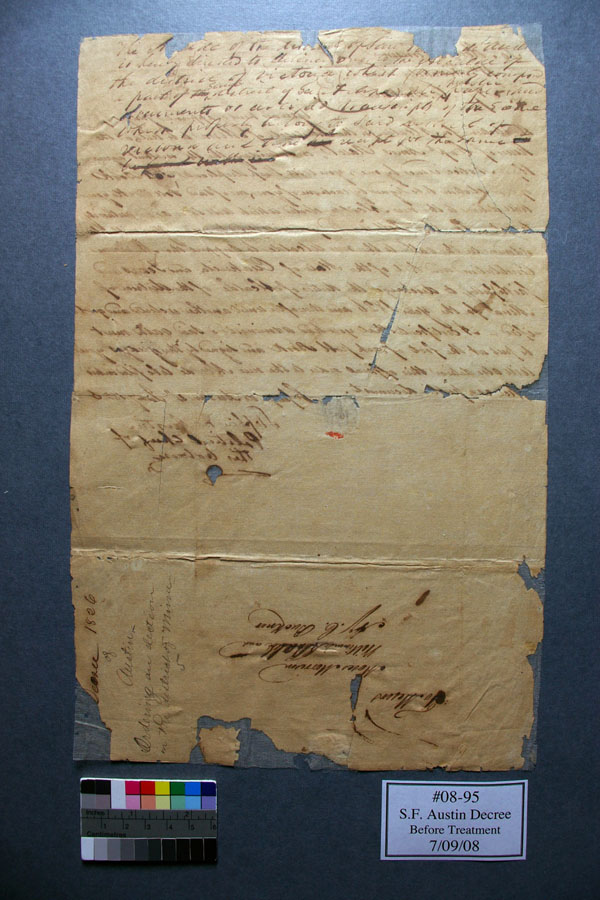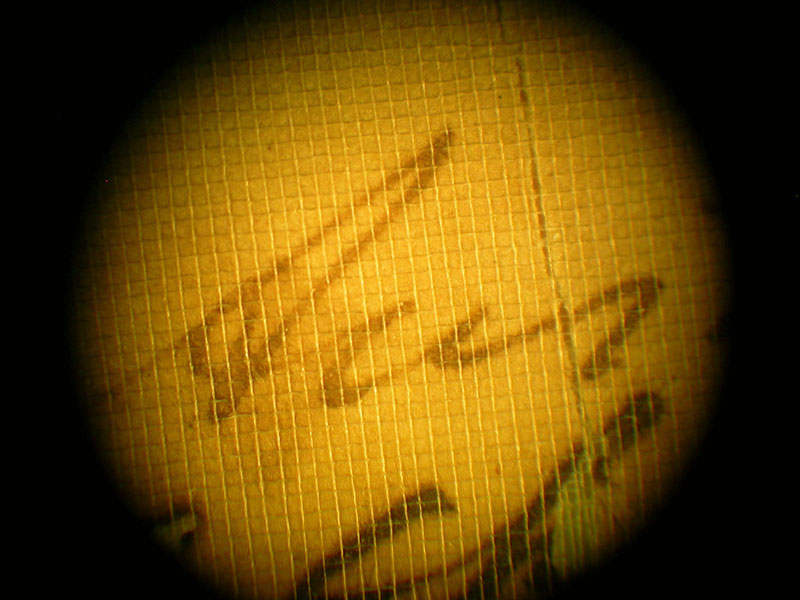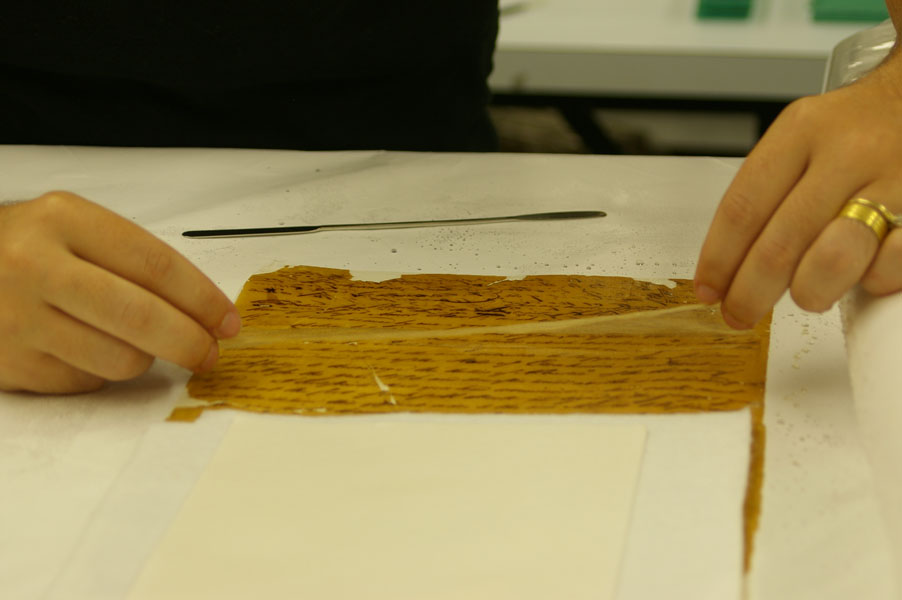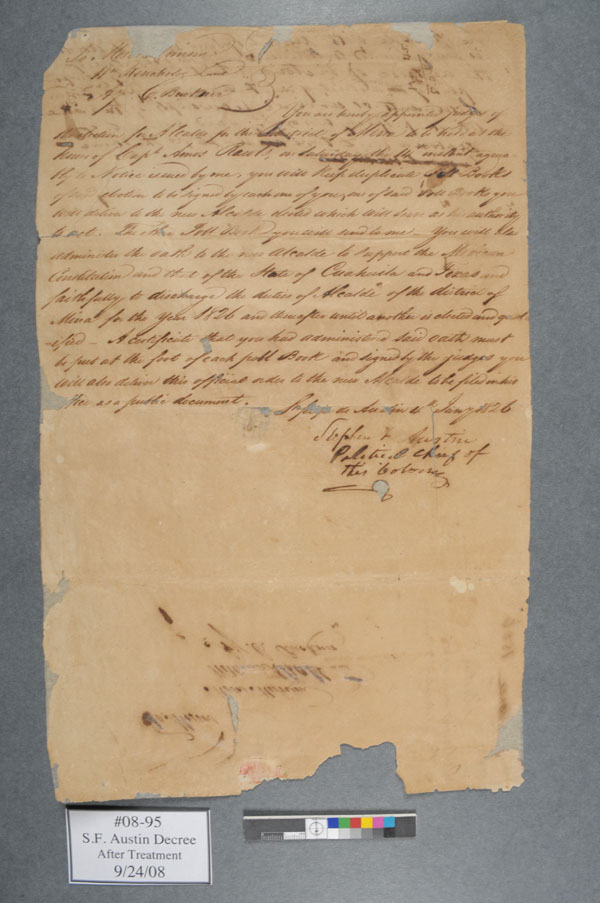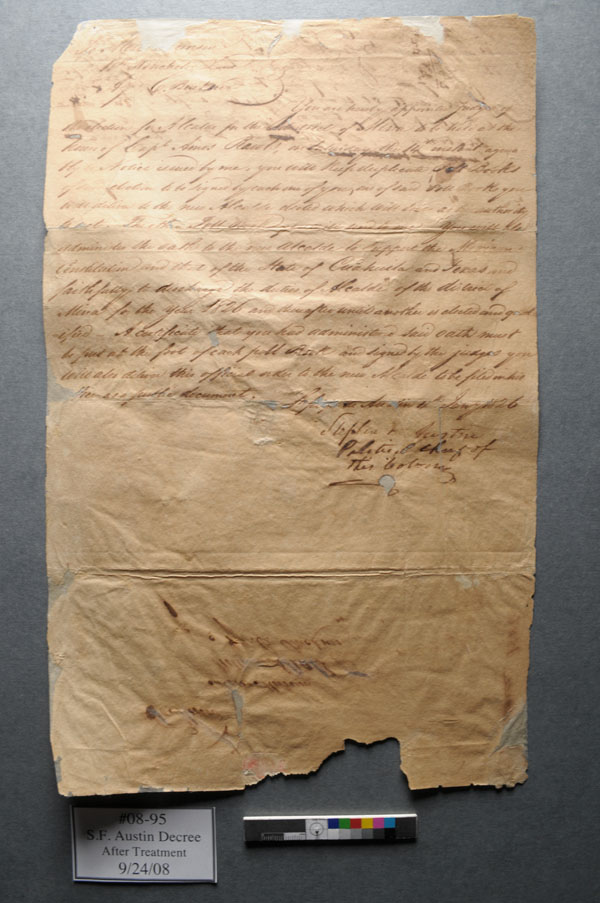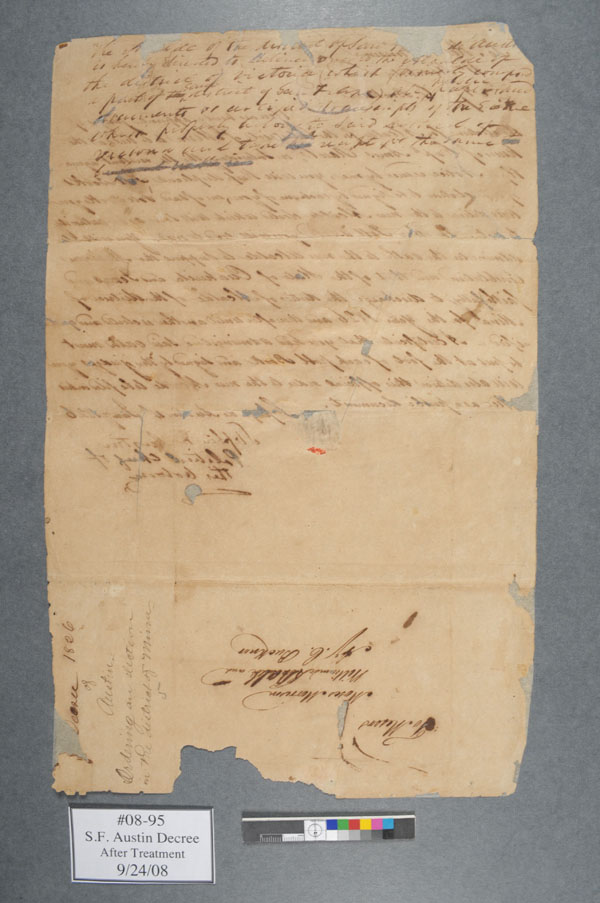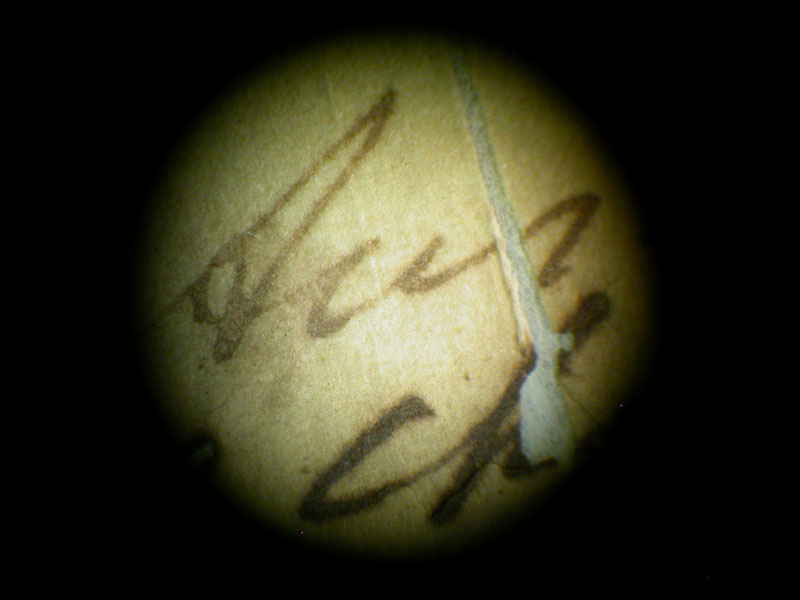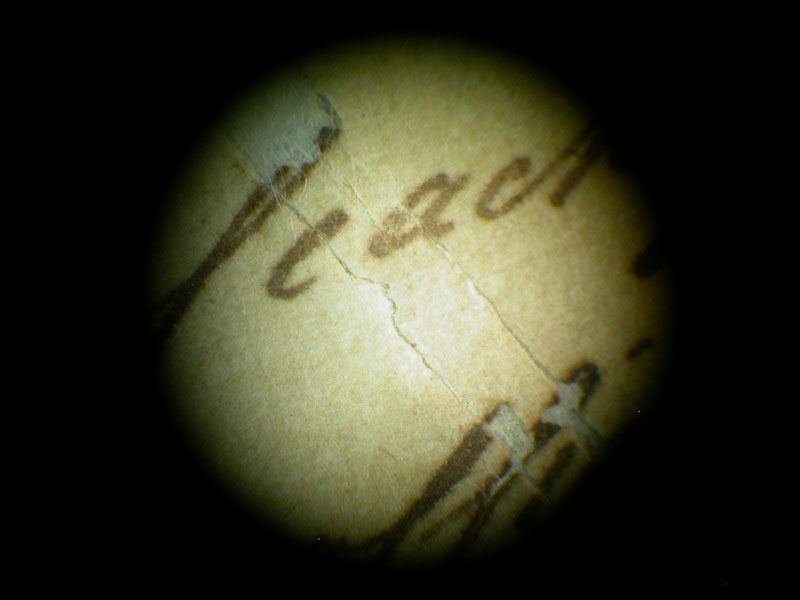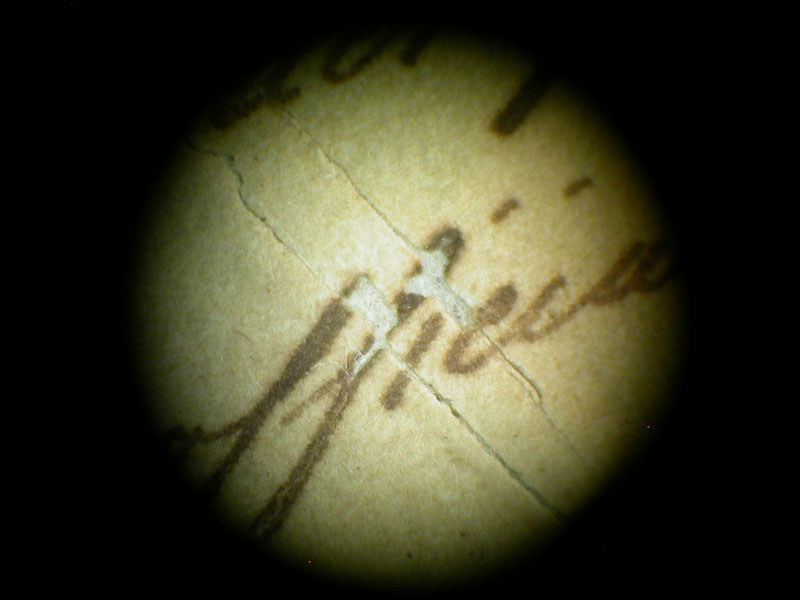Paper Treatments
Stephen F. Austin Decree, 1826
Silking removal, mending
Photo Documention
- Before
- During
- After
Click thumbnails to view images.
Treatment Report
Owner/Custodian: Stephanie Malmros
Address: Center for American History, University of Texas at Austin
Telephone: 512-475-4257
Owner/Custodian call no.: Stephen F. Austin Papers
Title/Subject/Description (.01): Stephen F. Austin Decree 1826
Creator: Stephen F. Austin
Date of production: 1826
Place of production: Texas
Approximate dimensions (hxw): 13½” x 8½”, 21.4 x 34.2cm
Conservator: Beth Antoine
Description
Primary support(hxw): 13½” x 8½”, 21.4 x 34.2cm
General
The manuscript is written in iron gall ink on a single leaf of wove, cream-colored handmade paper, which was folded and sealed for mailing.
Media
Iron Gall Ink
The iron gall ink is heavily applied and covers the top half of the recto and top quarter of the verso with tight margins. The signature is just below the middle horizontal fold of the recto, and the address is written on the bottom quarter of the verso.
Dark brown/black Ink
A cataloguer’s annotation describing the content of the letter appears in thinly applied dark brown, nearly black ink, on the bottom quarter of the verso of the sheet, next to the address.
Graphite
Likely a cataloguer’s annotation, the number “5” is written in a dense, dark gray graphite just below the dark brown/black ink on the bottom quarter of the verso.
Primary support
The manuscript is written on cream-colored, wove, handmade paper. The paper was folded in quarters horizontally and thirds vertically, and was sealed with an orange seal for mailing purposes. The paper is skinned around the seal from the letter being opened.
Seal
The bright orange seal is likely starch-based, as indicated by solubility testing. The remnants of the it are located at the bottom center of the recto and just below the middle fold of the verso, indicating the original points of attachment and manner of folding.
Condition
General
The manuscript is in poor condition overall with severe iron gall ink corrosion, several major tears and losses, and has been silked overall, front and back.
Media
Iron Gall Ink
The ink has faded to a dark brown color and halos under UV light. The ink is severely corroded in some areas with heavily applied letters having dropped out. All of the ink has sunk deep into the surface of the paper and is clearly visible from the back. Most of the ink cracking and letter drop-out occurs at the top quarter of the leaf where writing on the recto and verso overlap and in the most heavily inked areas of the signature and the address. A couple of heavily inked areas in the signature are covered with a white hazy deposit or discoloration, visible under magnification.
Dark brown/black Ink
The dark brown/black ink is in good condition with no signs of fading or corrosion.
Graphite
The graphite is in good condition with no signs of smudging.
Primary support
The paper is darkened to a brown color, indicative of the advanced stages of iron gall ink corrosion. It also exhibits reverse foxing, or a light, blotchy discoloration throughout. It is likely embrittled as it has torn at most folds, but the silking prevents the examination of this condition. There are several major tears, and the silking is currently holding the many fragments together. There are many small losses at the edges of the document. There is one fragment at the bottom center that appears to be misplaced and may belong at the top left edge of the recto.
Seal
The color of the seal remains vibrant and its attachment to the paper is strong. There is a layer of skinned paper covering the remnants of the wafer from the original attachment.
Testing
Under magnification, a drop of de-ionized water on a sable brush was touched to the silking and the surface of the paper. The silking easily detached from the paper with pressure from a tungsten needle, indicating that it is adhered with a water-soluble adhesive.
The seal was also tested for solubility with a drop of de-ionized water on a sable brush under magnification. The seal softened after one drop, indicating that it is quite soluble and is likely starch-based.
Treatment Proposal
- Remove silk from front and back of manuscript.
- Wash to remove residual adhesive, as possible.
- Alkalize as possible.
- Mend tears and fill losses as needed.
- House in acid-free folder.
Photography
Digital images taken before and after treatment, overall, recto and verso in ambient, raking, and transmitted light, as well as a photo-micrograph of the signature.
Possible Effects of Treatment
It is likely that there will be a slight shift in the color of the ink as a result of the alkalization. It is possible that the density of the ink will be slightly reduced.
Treatment Notes
See attached.
Treatment Performed
- The manuscript was humidified overall in a Goretex humidity chamber for 45 minutes, then sprayed out with de-ionized water in a Dahlia sprayer. (10 min.)
- The silk was lifted mechanically from the front and back with a micro-spatula and light force while still in the humidity chamber. (15 min.)
- The manuscript was washed in a calcified de-ionized water bath for 5 minutes and the adhesive residue was reduced with a stiff brush. (10 min.)
- After removal from the bath, the document was misted with alkalized de-ionized water (pH 9) and left to soak for 10 minutes. (5 min.)
- It was flattened between Hollytex, blotters, and boards with heavy weight for two weeks. (5 min.)
- The laminated fragments were detached with a micro-spatula after humidification with an Amylase enzyme poultice (Albertina-Kompresse) under light weight. (1 hour)
- The manuscript was then re-humidified in a Goretex chamber four one hour and flattened between Hollytex, blotters, and boards with heavy weight until dry. (10 min.)
- Tears were mended and losses filled using toned lens tissue (Green’s lens tissue and Liquitex acrylic paints) and de-ionized water diluted 2.5:1 precipitated wheat starch paste (Colophon) and weighted locally until dry. (13 hrs.)
- The manuscript was humidified in a tray chamber four three hours and flattened between Hollytex, blotters, and boards with heavy weight and left one week. (10 min.)
- The manuscript was re-housed in an acid-free folder. (5 min.)
Total treatment time: 15 hours, 5 minutes



